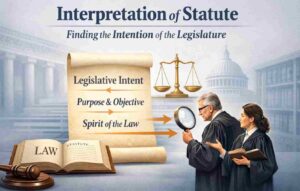Laws are like instructions that tell people what they can or cannot do. These instructions are written by a group of people called the legislature.
When judges need to figure out what a law really means, they look at the intention, or purpose, of the lawmakers who created it. This is called interpreting the law, and it helps judges make decisions that follow the law’s true purpose.
Let’s understand why understanding the legislature’s intention is so important and how it works.
What is Legislative Intent?
When lawmakers write a law, they often have a specific problem they want to solve. For example, they might want to make roads safer or protect people from unfair treatment. This goal or purpose is called the legislative intent. It acts like a guiding light for judges to understand the law better.
Why is Legislative Intent Important?
- Clarity and Fairness: Laws can sometimes be confusing or have words with more than one meaning. By understanding the lawmakers’ intention, judges can clarify the meaning of the law and ensure everyone is treated fairly. For instance, if a law says, “vehicles cannot enter the park,” does that include bicycles? Looking at the intent can help decide the answer.
- Respect for Lawmakers: The legislature makes the laws, and the judges apply them. By focusing on legislative intent, judges show respect for the lawmakers’ role and ensure they do not change or rewrite laws while interpreting them.
- Preventing Misuse of Laws: Without knowing the purpose behind a law, people might try to misuse it in ways the lawmakers never intended. By focusing on the intent, judges can stop this from happening and keep the law working as it was meant to.
- Promoting Justice: The ultimate goal of the legal system is to deliver justice. By interpreting laws according to their purpose, judges ensure fair outcomes that align with the spirit of the law.
- Avoiding Absurd Results: Sometimes, reading a law too literally can lead to strange or unfair results. For example, if a law gives benefits to “all citizens under 18,” it might not make sense to deny benefits to someone who turns 18 halfway through the program. Understanding the intent behind the law can help judges make practical decisions.
- Consistency in Decisions: When judges rely on the legislature’s intent, it helps maintain consistency in how laws are applied. This means similar cases are treated in similar ways, which makes the legal system more predictable and reliable.
- Dealing with New Situations: Laws are written at a specific time, but society changes. New technologies, like the internet or self-driving cars, can create situations lawmakers never thought about. By looking at the purpose behind a law, judges can decide how it applies to these new situations.
- Resolving Ambiguity: Sometimes, laws are not clear because they use broad or vague language. For example, a law might say, “No loud noises at night,” but what counts as “loud”? Understanding the lawmakers’ goal helps judges make sense of unclear terms.
- Filling Gaps in the Law: No law can cover every possible situation. When gaps appear, judges can use the legislature’s intent to fill those gaps in a way that stays true to the law’s purpose.
- Ensuring Public Trust: People are more likely to trust the legal system when they see that laws are interpreted fairly and consistently. Focusing on legislative intent helps build this trust by showing that judges respect the rules set by lawmakers.
How Do Judges Determine Legislative Intent?
Judges use several tools and methods to understand the lawmakers’ intentions. These include:
- Reading the Law’s Text: Judges start by looking at the exact words in the law. They assume the lawmakers chose these words carefully, so the meaning of the text is an important clue.
- Looking at Context: Sometimes, judges read the entire law to understand how different parts fit together. This helps them see the bigger picture and avoid interpretations that don’t make sense.
- Examining Legislative History: Judges may look at records from when the law was made, such as speeches, debates, or reports. These documents can provide insights into why the law was written and what the lawmakers were trying to achieve.
- Checking Purpose Clauses: Some laws include sections that clearly state their purpose. For example, a law about education might begin with a sentence like, “This law aims to ensure every child has access to quality schooling.”
- Using Legal Principles: Judges often follow established rules, called canons of construction, to interpret laws. For example, one rule is noscitur a sociis, which means a word’s meaning can be understood by the words around it. If a law lists “cars, trucks, and other vehicles,” the phrase “other vehicles” would likely include things like motorcycles, but not airplanes.
Examples of Legislative Intent in Action
Let’s consider a few examples to see how legislative intent works in real life:
Traffic Laws
If a traffic law says, “All vehicles must stop at a red light,” does that include bicycles? By looking at the lawmakers’ goal (promoting road safety), judges can decide that bicycles are included because they are part of traffic.
Environmental Protection
Suppose a law bans “dumping waste into rivers.” If a company claims that wastewater isn’t included because it’s not solid waste, judges can look at the law’s intent (protecting rivers) to decide that wastewater counts as waste.
Challenges in Understanding Legislative Intent
While legislative intent is important, it’s not always easy to determine. Here are a few challenges:
- Ambiguous Language: Some laws are written in ways that allow for multiple interpretations.
- Conflicting Opinions: Lawmakers might have disagreed on the purpose of a law, making it hard to identify a single intent.
- Changing Times: Words and ideas can change over time, so judges may need to consider how the law applies to modern circumstances.
Verdict
The intention of the legislature acts as a compass for judges, guiding them through the complexities of statutory interpretation. By aligning their decisions with the purpose behind the law, judges ensure that laws remain relevant, fair, and effective.
This approach not only upholds the integrity of the legal system but also strengthens public trust in the judiciary and legislature.















